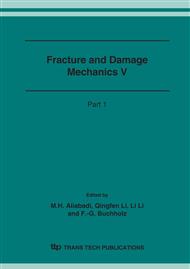p.1289
p.1293
p.1297
p.1301
p.1305
p.1309
p.1313
p.1317
p.1321
A Bi-Material Wedge – a Model for the Prediction of Failure Initiation at Shape and Material Discontinuities
Abstract:
Geometrical and material discontinuities in constructions lead to singular stress concentrations and consequently to a crack initiation. The model of a bi-material wedge makes it possible to analyse such construction points to assess their stability. The presented approach is based on the knowledge of the strain energy density factor distribution in the concentrator vicinity.
Info:
Periodical:
Pages:
1305-1308
Citation:
Online since:
November 2006
Authors:
Price:
Сopyright:
© 2006 Trans Tech Publications Ltd. All Rights Reserved
Share:
Citation:


